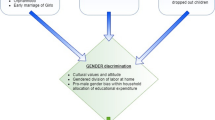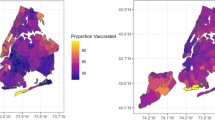Abstract
Basic services which are essential for the overall development of a child should not depend on circumstances such as caste, religion, gender, place of birth, or other parental characteristics, which are beyond his/her control. This paper uses two rounds of Indian National Family Health Surveys and concepts of Inequality of Opportunity and Human Opportunity Indices to measure inequality arising out of unequal coverage of full immunization and minimum nutrition for Indian children. The results suggest overall high level of inequality of opportunity with substantial geographical variations. Changes in inequality of opportunity in the two services during 1992–1993 to 2005–2006 were mixed with some geographical regions outperforming others. The findings also call for substantial policy revisions if the goal of universal full immunization and minimum nutrition has to be achieved.
Similar content being viewed by others
Notes
Details of states in each region have been provided in the subsection “dataset and estimation”.
The inequality of opportunity and human opportunity indices were developed by Barros et al. (2009) (also, see Barros et al. 2008) for Latin American and Carribean countries. I don’t take any credit for the conceptual development of these indices. The notations are retained in order to maintain coherence.
In a strict sense D is not defined when \( \bar{p} = 0 \). A close substitute D s , can be used where \( D_{s} = \frac{1}{{2\left( {1 - \beta } \right)}}\sum\nolimits_{i = 1}^{n} {\beta_{i} \left| {\hat{p}_{i} - \bar{p}} \right|} \). The interpretation will change a little where it signifies the proportion of all opportunities which need to be rearranged as a proportion of number of children who don’t have access to an opportunity. However if \( \bar{p} \) is zero, then the dissimilarity index doesn’t make any sense, but the human opportunity index will become zero showing no availability of the opportunity at all (Barros et al. 2009, p. 83).
The regression results were in expected direction. They can be provided on request.
References
Ahluwalia, M. S. (2002). State level performance under economic reforms in India. In A. Krueger (Ed.), Economic policy reforms and the Indian economy (pp. 91–128). Chicago: University of Chicago Press.
Bairagi, R. (1986). Food crisis, nutrition, and female children in rural Bangladesh. Population and Development Review, 12(2), 307–315.
Barros, R. P., Francisco, H. G., Vega, J. R. M., & Chanduvi, J. S. (2009). Measuring inequality of opportunities in Latin America and the Caribbean. Washington, DC: The World Bank.
Barros, R. P., Vega, J. R. M., & Chanduvi, J. S. (2008). Measuring inequality of opportunities for children. http://siteresources.worldbank.org/INTLACREGTOPPOVANA/Resources/IneqchildrenPaesdeBarrosMolinasSaavedra.pdf. Cited 5 Jan 2010.
Basu, A. M. (1989). Is discrimination in food really necessary for explaining sex differentials in childhood mortality? Population Studies, 43(2), 193–210.
Bhat, P. N. M. (2002). On the trail of ‘Missing’ Indian females. Economic and Political Weekly, 37(51), 5105–5118.
Bhat, P. N. M., & Zavier, F. (1999). Findings of National Family Health Survey: Regional analysis. Economic and Political Weekly, 34, 3008–3032.
Borooah, V. (2004). Gender bias among children in India in their diet and immunization against disease. Social Science and Medicine, 58, 1719–1731.
Bose, A. (1991). Demographic diversity of India—1991 Census, State and District level data. Delhi: B.R. Publishing Corporation.
Coalation For Sustainable Nutrition Security For India (CSNSI). (2008). Overcoming the curse of malnutrition in India: A leadership agenda for action. New Delhi: Secretariat, Safdarjung Enclave.
Das Gupta, M. (1987). Selective discrimination against female children in rural Punjab, India. Population and Development Review, 13(1), 77–100.
Davis-Kean, P. E. (2005). The influence of parent education and family income on child achievement: The indirect role of parental expectations and the home environment. Journal of Family Psychology, 19(2), 294–304.
Deaton, A., & Dreze, J. (2008). Nutrition in India: Facts and interpretation. Economic and Political Weekly, 44(7), 42–65.
Desai, S., & Kulkarni, V. (2008). Changing educational inequalities in India in the context of affirmative action. Demography, 45(2), 245–270.
Despande, A. (2001). Caste at birth? Redefining disparity in India. Review of Development Economics, 5(1), 130–144.
Dibley, M. J., Goldsby, J. B., Staehling, N. W., & Trowbridge, F. L. (1987a). Development of normalized curves for the international growth reference: Historical and technical considerations. American Journal of Clinical Nutrition, 46(5), 736–748.
Dibley, M. J., Goldsby, J. B., Staehling, N. W., & Trowbridge, F. L. (1987b). Interpretation of Z-score anthropometric indicators derived from the international growth reference. American Journal of Clinical Nutrition, 46(5), 749–762.
Dyson, M., & Moore, M. (1983). On kinship structure, female autonomy, and demographic behaviour in India. Population and Development Review, 9(1), 35–60.
Eccles, J. S., & Davis-Kean, P. E. (2005). Influence of parent’s education on their’s children’s educational attainments: The role of parent and child perceptions. London Review of Education, 3(3), 191–204.
Filmer, D., & Pritchett, L. H. (2001). Estimating wealth effects without expenditure data- or tears: An application to educational enrollments in states of India. Demography, 38(1), 115–132.
Government of India. (2006). Social Economic and Educational Status of Muslim Community in India. New Delhi: Government of India.
Gragnolati, M., Shekar, M., Dasgupta, M., Bredenkamp, C., & Lee Y. (2005). India’s undernourished children: A call for reform and action. Health Nutrition and Population (HNP) Discussion paper, Aug 2005, Washington, DC: World Bank.
Griffiths, P., Mathews, Z., & Hinde, A. (2002). Gender, family and the nutritional status of children in three culturally contrasting states of India. Social Science and Medicine, 55(5), 775–790.
Gupta, D. (1991). Social stratification. New Delhi: Oxford University Press.
Hasan, M. (2001). Legacy of a divided nation: India’s Muslims since independence. New Delhi: Oxford University Press.
Howe, L. D., Hargreaves, J. R., Gabrysch, S., & Huttly, S. R. A. (2009). Is the wealth index a proxy for consumption expenditure? A systematic review. Journal of Epidemiology and Community Health, 63, 871–877.
IIPS & ORCMacro. (1995). National Family Health Survey 1992–93, India. Mumbai: International Institute for Population Sciences and Macro International.
IIPS & ORCMacro. (2007). National Family Health Survey 2005–06, India. Mumbai: International Institute for Population Sciences and Macro International.
Jejeebhoy, S. J. (1993). Family size, outcomes for children, and gender disparity: Case of rural Maharashtra. Economic and Political Weekly, 28(35), 1811–1821.
Johnson, K., & Bradley, S. (2008). Trends in population and health outcomes: Further analysis of the 2006 Nepal Demographic and Health Survey. Calverton, MD: Macro International Inc.
Kishor, S. (1993). May God give sons to all: Gender and child mortality in India. American Sociological Review, 58, 247–265.
Knodel, J. E., & Wongsith, M. (1991). Family size and children’s education in Thailand: Evidence from a national sample. Demography, 28(1), 119–131.
Miller, B. D. (1981). The endangered sex: Neglect of female children in rural North India. Ithaca: Cornell University Press.
Mishra, V., Roy, T. K., & Retherford, R. (2004). Sex differentials in childhood feeding, health care and nutritional status in India. Population and Development Review, 30(2), 269–295.
Montgomery, M. R., Gragnolati, M., Burke, K. A., & Paredes, E. (2000). Measuring living standards with proxy variables. Demography, 37(2), 155–174.
Muhuri, P. K., & Preston, S. H. (1991). Effects of family composition on mortality differentials by sex among children in Matlab, Bangladesh. Population and Development Review, 17(3), 415–434.
Mukherjee, D., & Das, S. (2008). Role of parental education in schooling and child labour decision: Urban India in the last decade. Social Indicators Research, 89, 305–322.
Oster, E. (2006). Does increased access increase equality? Gender and child health investments in India. Chicago: University of Chicago.
Pal, P., & Gosh, J. (2007). Inequality in India-A survey of recent trends. DESA Working paper, no. 45, New York: Department of Economics and Social Affairs.
Pande, R. (2003). Selective gender differences in childhood nutrition and immunization in rural India: The role of siblings. Demography, 40(3), 395–418.
Pande, R., & Yazbeck, A. S. (2003). What’s in a country average? Wealth, gender and regional inequalities in immunization in India. Social Science and Medicine, 57, 2075–2088.
Pathak, P. K., & Singh, A. (2009). Geographical variation in poverty and child malnutrition in India. In K. K. Singh, R. C. Yadava, & A. Pandey (Eds.), Population, poverty and health: Analytical approaches (pp. 183–206). New Delhi: Hindustan Publishing Corporation.
Ram, F., & Roy, T. K. (2004). Comparability issues in large sample surveys—some observations. In T. K. Roy, M. Guruswamy, & P. Arokiaswamy (Eds.), Population health and development in India—changing perspectives (pp. 40–56). New Delhi: Rawat Publications.
Roemer, J. E. (1998). Equality of opportunity. Cambridge, MA: Harvard University Press.
Rutstein, S. O., & Johnson, K. (2004). DHS comparative report 6: The DHS wealth Index. Calverton, MD: ORC Macro.
Sen, A. (1988). Family and food: Sex bias in poverty. In T. N. Srinivasan & P. K. Bardhan (Eds.), Rural poverty in South Asia (pp. 346–368). Ithaca: Oxford University Press.
Sen, A., & Himanshu, (2005). Poverty and inequality in India: Getting closer to the truth. In A. Deaton & V. Kozel (Eds.), Data and dogma: The great indian poverty debate (pp. 177–199). New Delhi: Macmillan.
Sharma, K. L. (1999). Social inequality in India: Profiles of caste, class and social mobility. Jaipur: Rawat Publications.
Singh, A., Hazra, A., & Ram, F. (2008). Women’s autonomy and sex differential in child mortality in India. Genus, 63(3–4), 55–75.
Vyas, S., & Kumaranayake, L. (2006). Constructing socio-economic status indices: How to use principal component analysis. Health Policy and Planning, 21(6), 459–468.
Wagstaff, A., & Watanabe, N. (2000). Socioeconomic inequalities in child malnutrition in developing world. Policy research working paper 2434, Washington DC: World Bank.
World Bank. (2006). World Development Report 2006: Equity and development. Washington, DC: World Bank.
World Health Organization Multicenter Growth Reference Study Group. (2006). WHO child growth standards: Length/height-for-age, weight-for-age, weight-for-length, weight-for-height and body mass index-for age—methods and development. Geneva: World Health Organization.
Acknowledgments
Author is indebted to Dr. Sripad Motiram for guidance and suggestions. Author is also indebted to Dr. Abhishek Singh for providing useful comments which helped immensely in improving the paper.
Author information
Authors and Affiliations
Corresponding author
Rights and permissions
About this article
Cite this article
Singh, A. Inequality of Opportunity in Indian Children: The Case of Immunization and Nutrition. Popul Res Policy Rev 30, 861–883 (2011). https://doi.org/10.1007/s11113-011-9214-5
Received:
Accepted:
Published:
Issue Date:
DOI: https://doi.org/10.1007/s11113-011-9214-5




